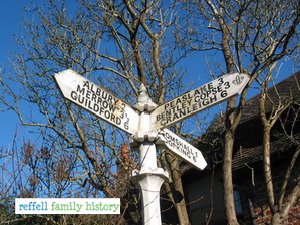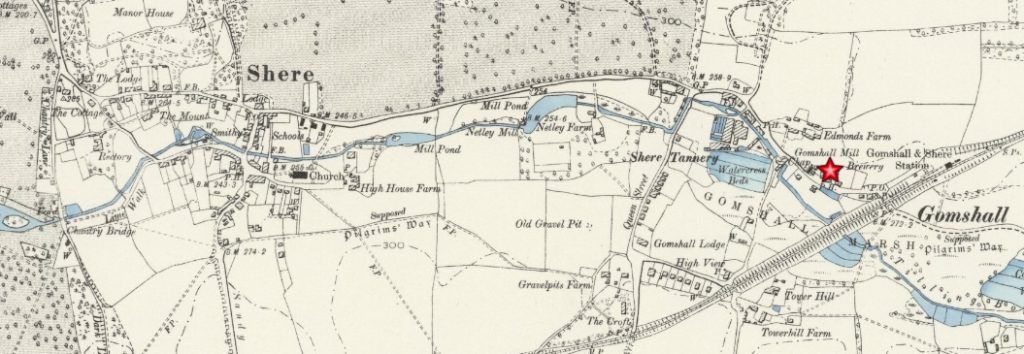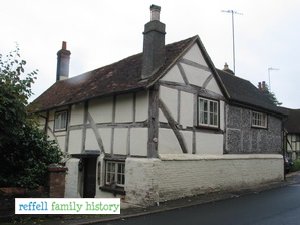‘The Prettiest Village in Surrey’

The village of Shere is a natural magnet for tourists and can be very busy at times. The small streets are usually clogged up with traffic, but it remains a jewel in a lovely area of the country. History is all around in Shere. As can be seen on the signpost on the right, it is about half way between Guildford and Dorking, just south of the old A25.
Shere appears in Domesday Book of 1086 as Essira and Essire. At that time it was held by William the Conqueror and consisted of 1 church, 2 mills worth 10s, 14 ploughs, 3 acres of meadow and woodland worth 50 hogs. Today Shere is also a civil parish, consisting of the villages of Shere, Gomshall, Holmbury St. Mary, Peaslake, and most of Abinger Hammer. It is part of the census ward of Tillingbourne which had a total population of 5,216 in 2001. The river Tillingbourne runs through the centre of the village.

The parish of Shere is firmly entwined in the history of the Reffell family. A large number of gravestones of the family can be seen in the churchyard of St James. The descendants of this branch of the family spread out into many areas of the United Kingdom and beyond. Some were the originators of the breweries in the family and were present in the area up until quite recently. Others led onto the large London-based branch of the family.
The first Reffell brewery was at nearby Gomshall, located behind the Black Horse and originates from 1817 (see red star on map above). The old Shere Museum was located in an old Malt House that dates from about 1830 and was used in the preparation of the ingredients for the beer that was brewed at Gomshall.
There were two public houses in Shere; the White Horse and the William Bray (previously the Prince of Wales and before that Cook’s Beer House), both of which were at one time supplied with beer from the Gomshall Brewery. Shere was an open parish and not dependent upon one noble family. There was some gentry in the area, the Bray family was the main one and they have held at least one of the manors (and sometimes all four) from 1485 up to the present day. William Bray (1736-1832) was a solicitor & historian.

John Reffell (1746–1798) lived in the house called Denton. During restoration works in 2003, a child’s shoe thought to be around 400 years old was found in one of the ceilings. The building dates from about 1550 and was previously owned by the Kelsey & Denton family. John took a lease for 11 years on Denton on 16 November 1776, where his occupation was stated to be an inn holder. He could have been landlord at the White Horse as he appears to have been living there at a later date. On 26 November 1794, there was a covenant to levy a fine from John (then stated to be a victualler) on Denton to Edward Bray, the Lord of the Manor at that time.
The fortunes of the Reffell family in the area seem somewhat mixed with some of the family depending upon poor relief, yet others were fairly prosperous. Ann Noyes’s book ‘Shere Poverty’ details much of the reliance on poor relief for many of the families in Shere, including a request in 1779 for help with a doctor’s bill for £2 2s for mending the broken leg of the (unnamed) wife of Thomas Reffell.
Many thanks for much information over the years go to Elizabeth Rich, Ann Noyes and others from the Shere and Gomshall Local History Society. ‘Shere Poverty’ was published by Twiga Books in 1996 (ISBN952862506)